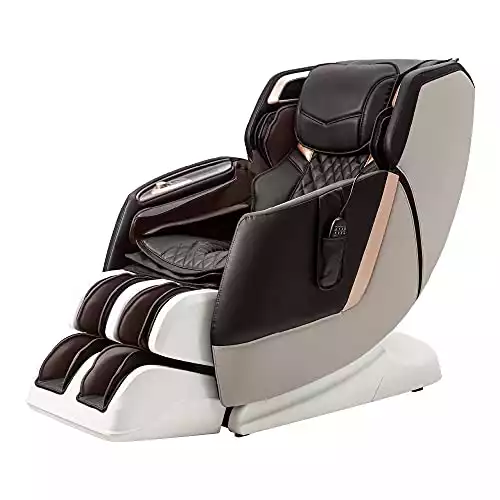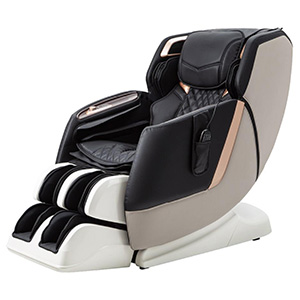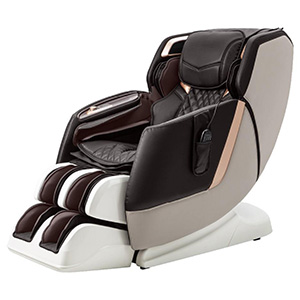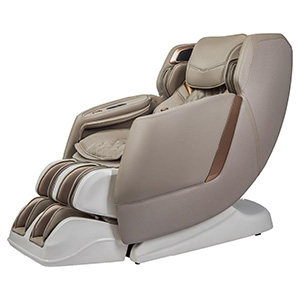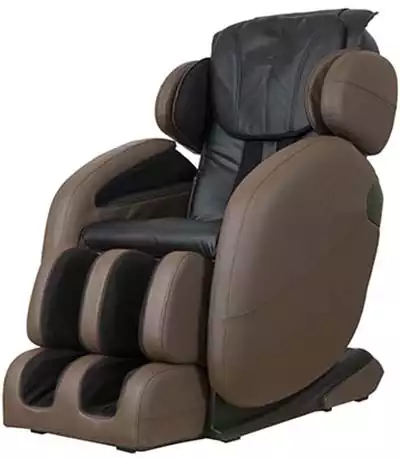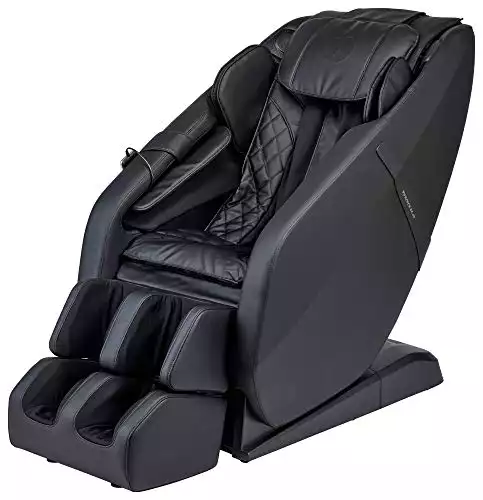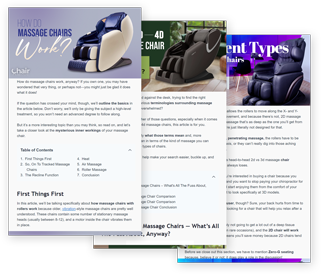In a Nutshell:
The Osaki AmaMedic Juno II is a very strange chair. While some of the features are competently implemented, certain design choices make this a frustrating chair to use or own. We cannot, in good conscience, recommend this model. Although some users may find it to their liking, it’s just got what we feel are some critical design flaws, and there are better, comparably priced options available.
Overall Massage Quality
Customization options
Ease of Use
Value for the Money
Brand Reliability*
Overall Rating
4/5
Benefits
Drawbacks
We cannot, in good conscience, recommend this model. Although some users may find it to their liking, it’s just got what we feel are some critical design flaws, and there are better, comparably priced options available.
Does your back hurt all the time? What about your legs and feet? If you suffer from chronic pain, you probably spend more time and money than you like making regular visits to a chiropractor nearby.
If you do, one of the things that likely prompted your search for a good massage chair is the idea that if you find the right one, you can save on trips to the chiropractor’s office and make your life more convenient.
It’s a great idea, and there are lots of high-quality massage chairs out there that can do that for you.
Unfortunately, you’ll find out in our AmaMedic Juno review that this isn’t one of those chairs.
That’s a real pity, too, because Osaki—the company behind the Titan brand and the creators of the AmaMedic massage chairs—has a spectacular reputation in the industry and normally makes great massage chairs.
We regard this one as a swing and a miss, and in the following sections, we’ll tell you exactly why. Make no mistake, this chair gets some things right and has many well-implemented features.
Sometimes though, features can be combined in unfortunate ways that make the design as a whole a failure, and in our view, that’s what we see here. Let’s take a closer look at how and why we reached that conclusion and see if you agree or disagree with our thinking.
An Overview of the Osaki Amamedic Juno II Massage Chair
Although this chair looks a lot like most of the other massage chairs on the market today, Titan/Osaki did take the step of making it available in your choice of black, brown, or taupe. So while it will tend to stick out unless your home is decorated with a futuristic or sci-fi theme, it’s at least fairly easy to blend it with the prevailing color scheme in your home, and that’s a plus.
This isn’t the biggest massage chair on the market, but it’s not tiny either. It has a footprint of 57.1″ L x 29.5″ W x 42.9″ H when sitting upright and 67.3″ L x 29.5″ W x 33.5″ H when fully reclined and weighs in at 177.5 pounds.
That’s actually surprisingly lightweight, but it’s still too heavy for most folks to wrestle into position without some additional assistance.
Note that the chair is designed with space-saving technology built in, which means that you’ll only need 3″ of clearance between the seatback and whatever wall you place it near. This should make it easier to find a permanent home for it, which is another plus.
Unfortunately, the Juno II has what we feel is a critical weakness. It only supports 220 pounds of user weight. Sure, if you weigh less than that, it won’t be an issue for you at all.
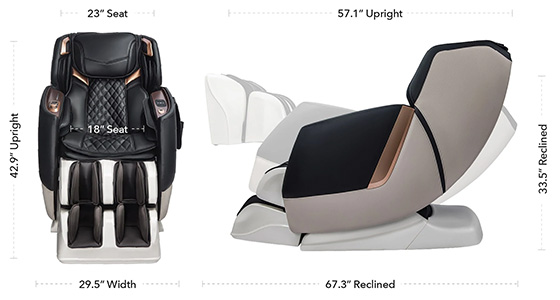
Most massage chairs on the market today, though, support in the neighborhood of 300 pounds, making them accessible to a broader swath of the market. This one falls well short of that informal standard.
If this was the chair’s only weakness, we could still recommend it, at least provisionally. But let’s take a closer look at the chair’s capabilities and see what we can unearth in terms of strengths and weaknesses.
The Juno II Massage Chair Is Designed With An Odd Mix Of Old And New Technology
There are some things we really like about this and others that we don’t, so we’ll call this a relatively weak component of our AmaMedic Juno review. In our view, these are the basic things that make a massage chair tick, and if you don’t nail the basics, then no matter what else you do, the overall quality of the chair is going to suffer.
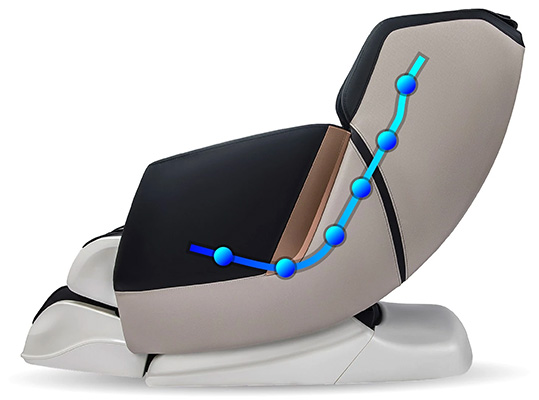
For starters, we like the SL-Track. It starts in the neck/shoulder region of the seatback, travels down the length of the seatback, and then turns and goes under the seat, allowing the rollers to massage your glutes and the backs of your thighs.
We also like the quad rollers, which are the current industry standard. So far, so good.
Unfortunately, the massage track only allows the rollers to move along the X-or Y-axis. There is no Z-axis movement, so this chair cannot render a deep tissue massage.
If you’re looking for a massage chair that will replace periodic visits to your local chiropractor and your visits include a deep tissue massage, then this chair isn’t going to get it done for you.
In addition to that, the chair utilizes an old-school wired remote that we don’t feel is very well designed, and the lack of refinement here makes the chair somewhat more difficult to use.
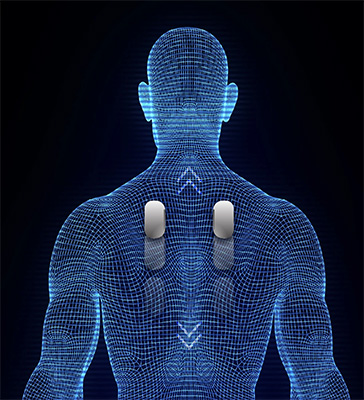
On the other hand, convenience controls are built into the chair itself, which is a genuinely nice touch. And the chair features Osaki’s excellent body scanning tech, which quietly adjusts the position of the rollers before your massage begins to ensure that they hit your pressure points appropriately.
Even better, on those occasions where the body scan doesn’t get it quite right, you’ll find controls on the remote that allow you to manually tweak the position of the rollers, which is excellent.
See what we mean, though, about some good, some bad? That’s not necessarily the kiss of death, but again, this is massage chair 101. We were kind of stunned that Osaki cut corners here.
The Juno II Offers A Surprising Number Of Massage Options
Despite some basic points of weakness in the overall design, we found a lot to like here in terms of massage capabilities. For starters, the Juno II brings six massage techniques to the table. These are:
This is…almost absurdly good.
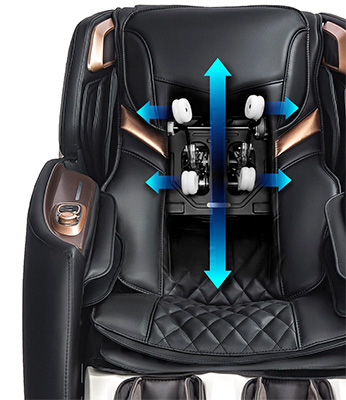
You almost never find a chair offered at this price point that features two advanced techniques, and we’ve seen less than a dozen chairs in total that offer Swedish as a technique.
That puts the Osaki Juno II in an exclusive club indeed.
Unfortunately, access to the Swedish technique is blunted by the fact that this is only a 2D massage chair, so you’re not going to get as much out of that advanced technique (or Shiatsu, for that matter) as you would from a 3D chair.
In addition to that, the implementation of the techniques is dodgy. Rather than a separate button for each technique, you just keep pressing the technique button, which cycles through them. So you either have to look up in the manual to see how many button presses take you to your preferred technique, or you just have to memorize it.
That’s not the worst thing in the world, but it does make the chair “fiddly” and kind of annoying to use in the longer term.
In any case, two advanced techniques are impressive, and we’ll rate the Swedish technique’s presence as one of the design’s signature features.
In addition to that, you’ll find ten auto-programs on offer. These are:
These are all excellent options, and you’ll definitely want to spend some time experimenting with them to see what you like best. Six of the options are well implemented, with their buttons on the remote, but four are buried in a sub-menu and somewhat harder to access.
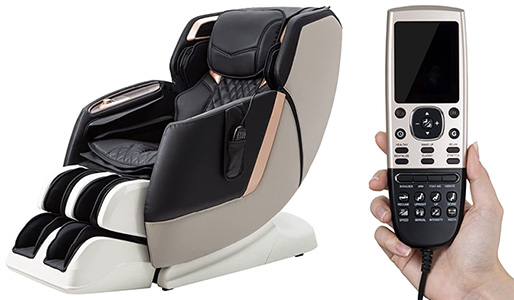
This is another weak spot in the design and layout of the control system. It wouldn’t have been hard to just squeeze the buttons together and make room for four more—bad design.
The big feature to talk about here is the body stretch. While Osaki doesn’t have the best body stretch in the industry, it’s pretty good and has definite therapeutic value.
The body stretch here is somewhat weaker than on other Osaki models but is still good enough to provide genuine therapeutic value, which is excellent. If your favorite part about a trip to your local chiropractor’s office is the “adjustment,” then this will probably wind up being your favorite aspect of the design.
In addition to that, you’ll find five levels of speed and five levels of intensity adjustment, plus spot and partial modes.
That’s huge. It gives you a simply tremendous number of massage options to play with. Again though, the limiting factors are the poor design of the remote—which makes some of these features annoyingly difficult to access—and the fact that the track isn’t designed to allow Z-Axis movement.
Zero-G Seating Is Included
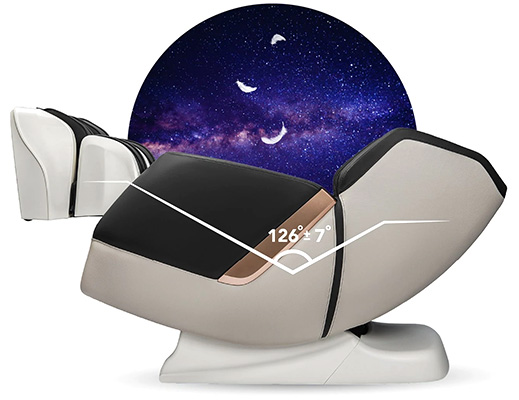
This is a relatively strong component of our AmaMedic Juno review. Less than half of the massage chairs on the market today offer Zero-G seating, and given the modest price of this model, we are pleased to see it here.
It is competently implemented, although there are only two Zero-G seating options on offer.
Even so, Zero-G has genuine therapeutic benefits. It helps lower your blood pressure and generally improves your circulation. And if you order a massage while in the Zero-G position, it will increase its intensity slightly. It’s still not a deep tissue massage at that point, but it is a little closer to that mark.
Lumbar Heat—Kind Of…
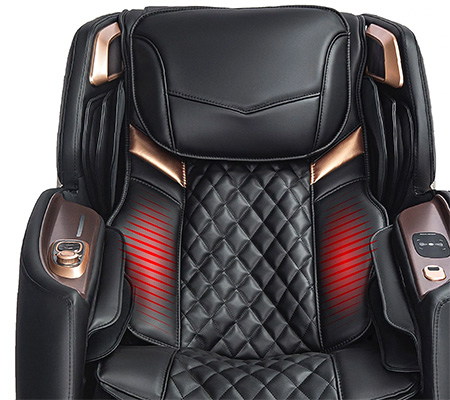
We have a love/hate relationship with the Juno II’s implementation here. On the one hand, heat is always a welcome addition to any model, and its presence here gives the chair another therapeutic feature.
On the other hand, the twin heating coils are placed on either side of the chair, and the heat winds up hitting your sides more than the lumbar region of your back.
The heat will feel amazing if you’ve recently suffered cracked or broken ribs. But if you want heat on the small of your back, you’re only going to get a little as it radiates out from the heating coils, so although we love that the feature is present, we’re less than thrilled about the implementation here.
A Decent But Unexceptional Air Massage
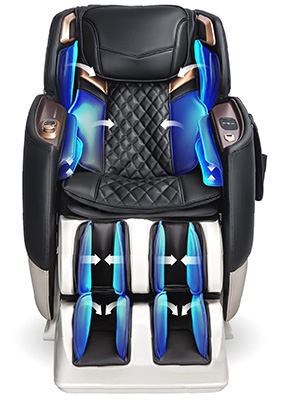
This is an about average component of our Amamedic Juno review. The chair sports 36 airbags, located such that it will massage your shoulders, arms, and feet. Where you get an air massage, it’s quite good, but the airbag-based massage is somewhat limited, though you can adjust the strength via the remote, choosing from among five different intensity levels.
We sense that the airbags are mostly present to facilitate the calf and foot massage and keep your body stationary when using the stretch function. The massage itself is sort of an afterthought.
It’s not an awful feature; it’s just not something that people will get excited about and decide they must have this chair in particular over some other model.
Note that you can selectively activate only some airbags (shoulders, arms, feet) if you don’t want them all running at once.
A Competently Implemented Calf And Foot Massage

This is another good but not great feature implementation. Even so, we’d still rate this as being one of the stronger components of our AmaMedic Juno review and better-than-average feature implementation.
The calf massage is rendered via airbags, and a combination of airbags and rollers attends to the soles of your feet. It’s a good combination that offers a relaxing experience, and if you spend several hours of each day on your feet, you’ll almost certainly love this feature.
Several High-Value Extras And One Forgettable One
The Juno II offers a surprising number of extras, but it’s a mixed bag.
The best “extras” are the Bluetooth speakers and the handy USB port. This combination allows you to keep your phone charged, sync it to the speakers, and enjoy your favorite music or catch up on podcasts while getting a massage. Excellent.
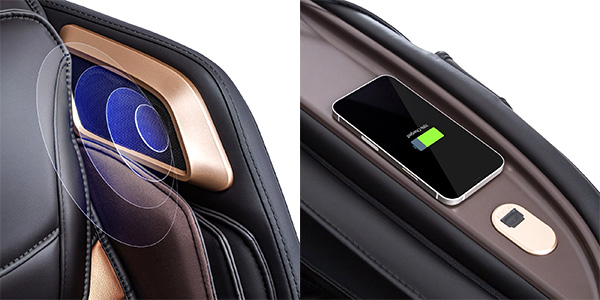
A step down from that would be the presence of the massage timer.
We love that this chair has one, but the massage timer only goes to a maximum of 30 minutes. All massages default to a 15-minute duration, and you can adjust the time by 5-minute increments to a minimum of 5 minutes and an absolute max of 30.
The thing is, it’s not hard to find massage chairs that have massage run times of up to an hour.
Is it the end of the world that this one doesn’t? No, all you have to do is order another massage after the first one ends if you want more. But the fact is, you have to do that, which can get annoying.
Finally, the “extra” that we rate as forgettable is the fact that there are vibration plates in the seat.
You almost never see vibrating massage in chairs offered by mainstream brands. It’s most often paired with massage chairs designed around stationary massage heads and offered by off-brands. Its presence here is something of a mystery.
Anyway, it’s worth checking out. You may love it. We’re not fans, but your mileage may vary.
Pros & Cons of Osaki AmaMedic Juno II
So, where does that leave us?
As we said at the start, this chair does get some things right, and what it gets right, it does pretty well.
Unfortunately, there are a number of design missteps that just make it a frustrating model.
In our view, the best aspects of the design are:
On the other hand:
AmaMedic Juno Review Conclusion
While many of the Juno II’s features are competently executed and have some strong points to recommend it, overall, we have a negative opinion of this chair and cannot, in good conscience, recommend it.
Other Options To Consider
If you agree with our thinking and you’ve decided to take a pass on this chair, here are a couple of other models you may want to take a closer look at:
Recommended For: Hobbyist/casual users, chronic pain sufferers, and taller users, almost anybody, will love this chair!
This chair is a bit more expensive than the one we just reviewed, but it’s well worth the additional cost. We consider this chair the best value in the massage chair world today. It’s packed with features, including a number of therapeutic features, and offers one of the best body stretches in the industry today.
Recommended For: Anyone weighing up to 300 pounds who is on a budget and doesn’t have a specific therapeutic need.
This is an amazingly good little chair, especially given that it’s offered by a smaller brand you may not have ever heard of. It’s absolutely true that it’s got its share of limitations, but for the money, we’re mightily impressed. This chair punches well above its weight class and doesn’t cost as much as the one we just reviewed.
References & Resources:
- Osaki Massage Chair, Official Brand Website.
- Osaki AmaMedic Juno Ii Massage Chair User Manual
- Reflexology versus Swedish Massage to Reduce Physiologic Stress and Pain and Improve Mood in Nursing Home Residents with Cancer: A Pilot Trial, Hindawi.
- Six Versus Twelve Weeks of Swedish Massage Therapy for Generalized Anxiety Disorder: Preliminary Findings, Science Direct.
- Massage Can Help Treat Lower Back Pain, TIME Magazine.
